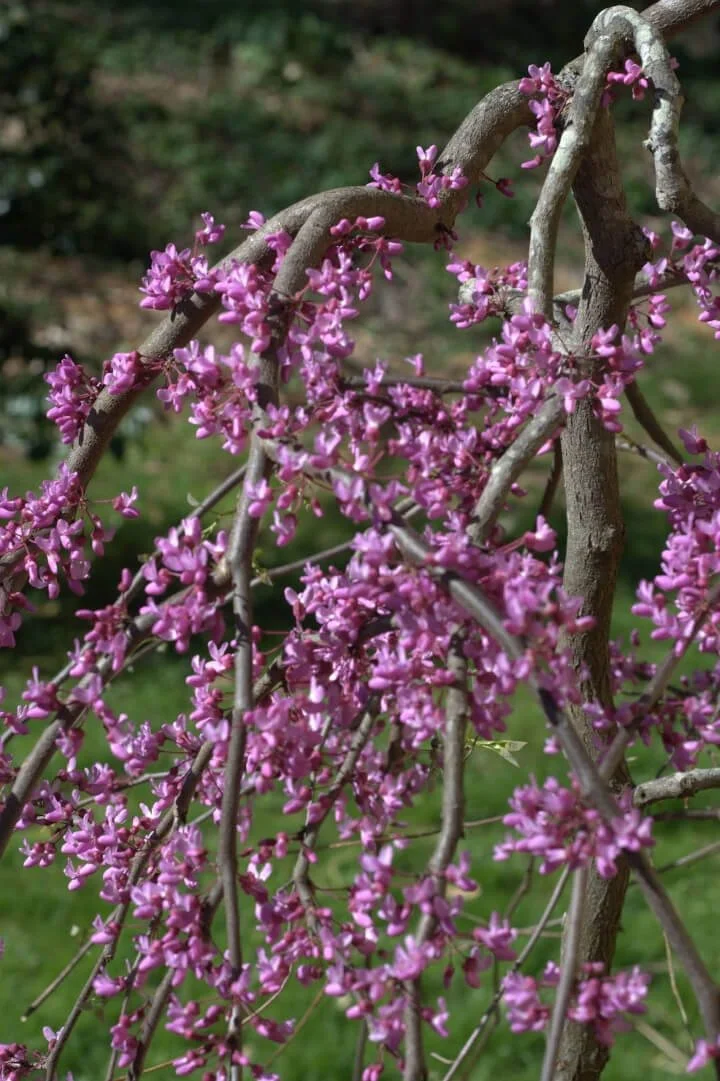Tree of the Month: Eastern Redbud
One of the earliest and brightest spring bloomers, the vivacious eastern redbud is a beautiful, hardy tree that offers benefits to the local ecosystem throughout the year. It’s a popular option as an ornamental tree for gardens and along streets and walkways, but it can also be found growing happily in wilderness areas. Here, we’ll look closely at this indispensable American species.
Cercis canadensis
The eastern redbud (Cercis canadensis) is a small deciduous tree that grows wide, meandering limbs from multiple lead branches, which can become knobby over time. While most redbuds have a single trunk, some specimens can develop several. The flaky bark of the tree is medium to dark brown or tan in color, and as the bark peels back, it exposes reddish interior wood. An eastern redbud displays a fine bare form during winter, and in the spring, specimens burst with a floral show for which the tree is prized.
Redbud trees are among the first tree species to blossom in the earliest weeks of spring. Their bright pinkish-purple flowers grow in tight, soft bunches not only on the tree’s twigs, but along the inner branches as well (this is known as “cauliflory”). The flowers of a redbud are particularly attractive to bees while in bloom.
After the flowers are pollinated, eastern redbud trees develop small, flat seed pods that are two to three inches long. The pods ripen over summer, then turn brown in the fall, dangling in clusters until they drop (it’s not unusual for the dried pods to hang onto the branches throughout the cold season).
Eastern redbud leaves are three to five inches wide, with a smooth edge. Each leaf has two wide lobes by the stem and comes to a point at the end, creating distinctively heart-shaped leaves that make up the redbud’s summer foliage. Most redbuds have green leaves, but some cultivars are dark red (such as Forest Pansy and Ruby Falls).
Where Is the Best Place to Plant a Redbud Tree?
The eastern redbud is native to lowland woods and stream banks, growing well on sloping land and in open canopy understories. For planting purposes, this means that eastern redbud trees prefer well-drained (loamy or sandy) soil, and they have great shade tolerance. Redbuds can tolerate full sun, and they also thrive when planted near tall canopy trees.
Eastern redbuds grow to a height of up to 30 feet (at a quick pace of up to a foot or two per year), with a spread equal to or a bit wider than their height. There are also smaller and dwarf cultivars of the tree that are even more compact than the standard species.
Are Redbud Flowers Edible?
The flowers of an eastern redbud are edible! They have a mild, sweet taste that is similar to a green pea (they are, after all, part of the legume family!). Redbud flowers can be eaten raw in salads and as a garnish, made into jam or jelly, or brewed in tea (just be sure to harvest them from trees that haven't been treated with pesticides). The seed pods, however, are not edible.
Redbuds Around Nashville
Redbuds offer various ecosystem services where they’re planted, such as stabilizing soil and providing summer cover for songbirds such as mockingbirds, cardinals, orioles, and chickadees. Redbuds also provide important habitats for caterpillars of native moth and butterfly species, which have effects throughout the local ecosystem as decomposers, pollinators, and sources of food for larger wildlife.
Keep an eye out for redbud trees in Nashville yards and parks; they won’t be hard to miss! If you have space in your yard for a new understory tree, check out the Nashville Tree Conservation Corps’ tree sale for the right specimen. Otherwise, consider volunteering with us to help plant a tree or take care of one, or donate a tree for us to plant!
Nashvillians can also donate a dollar amount to NTCC, the entirety of which goes to funding tree planting and care. Our all-volunteer organization relies on the support of the community to make this important work happen! Subscribe to our email newsletter to stay updated on our activities in service of our city’s canopy, and check out our Linktree for more ways to connect!

